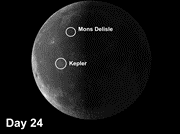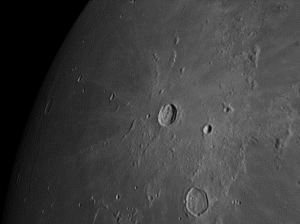The week of November 9-15 takes us from Lunar Day 23 to Day 1. This week we will highlight Kepler and Mons Delisle, viewable early Tuesday morning.
 Mons Delisle: [NW/G6] The over-imaginative among us say that if you catch it in the right light this curved mountain range, located just southwest of Delisle crater, resembles a baby with an oversized head, two outstretched arms, and trailing legs. The baby is speedily crawling southward not far from a nearby unnamed mountain group to its northwest which has informally been named “the Skull.” Your creative challenge for the evening is to see if you can turn the above named features into a baby and a skull.
Mons Delisle: [NW/G6] The over-imaginative among us say that if you catch it in the right light this curved mountain range, located just southwest of Delisle crater, resembles a baby with an oversized head, two outstretched arms, and trailing legs. The baby is speedily crawling southward not far from a nearby unnamed mountain group to its northwest which has informally been named “the Skull.” Your creative challenge for the evening is to see if you can turn the above named features into a baby and a skull.
 Kepler: [NW/J6] Kepler is a substantial 20-mile crater with terraced walls and some disappointingly feeble hills in place of a central mountain peak. There is a peculiar straight gash just in from the east rim which forms a long straight valley. Revisit Kepler at full Moon to appreciate how its rays intertwine with those of Copernicus and Aristarchus.
Kepler: [NW/J6] Kepler is a substantial 20-mile crater with terraced walls and some disappointingly feeble hills in place of a central mountain peak. There is a peculiar straight gash just in from the east rim which forms a long straight valley. Revisit Kepler at full Moon to appreciate how its rays intertwine with those of Copernicus and Aristarchus.
======================
It is highly recommended that you get a copy of Sky and Telescope’s Field Map of the Moon, the very finest Moon map available for use at the telescope. It is available for $10.95 at www.skyandtelescope.com and on Amazon. All features mentioned in this blog will be keyed to the grid on the Field Map and will look like this: Plato: [NW/D9]
Credits:
Courtesy of Gray Photography of Corpus Christi, Texas
Lunar photos: NASA / USGS / BMDO / LROC / ASU / DLR / LOLA / Moon Globe. Used by permission
- Rupes Cauchy: A Best Known Fault on the Moon - July 22, 2024
- Moon Crater Schickard – Crater Floor has Stripes - July 15, 2024
- Moon Craters Langrenus and Vandelinus - July 8, 2024